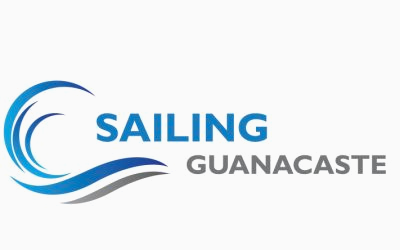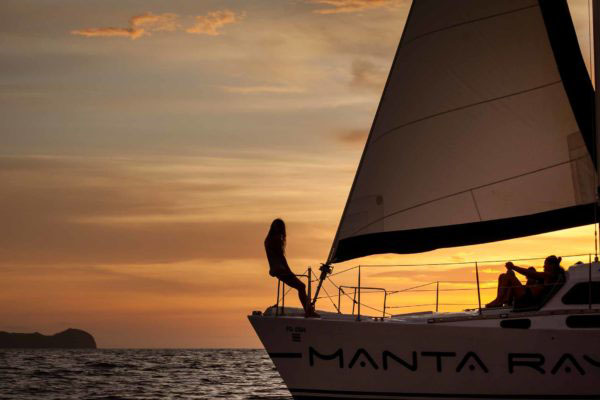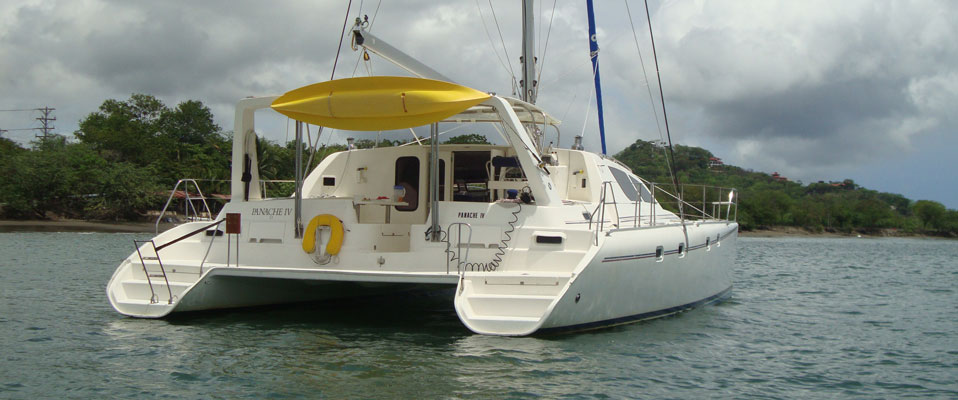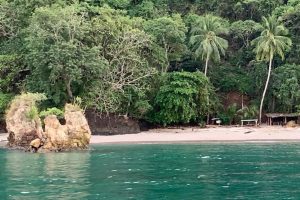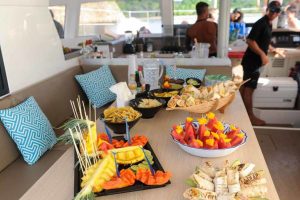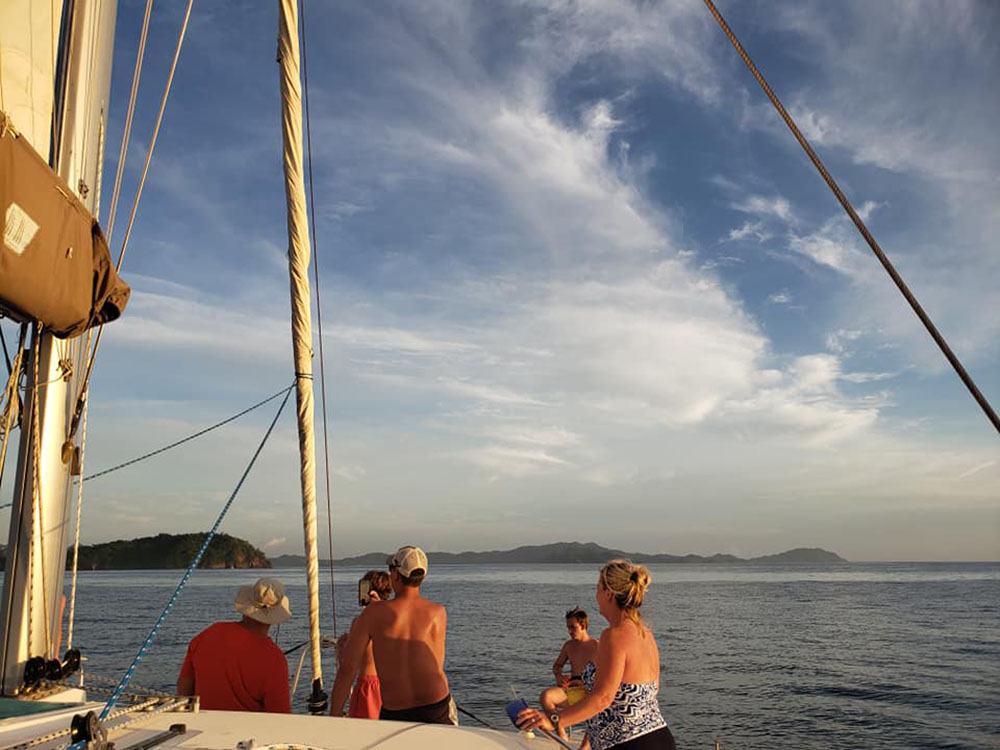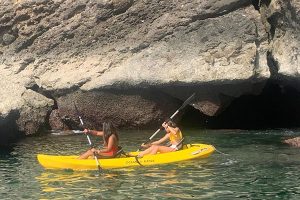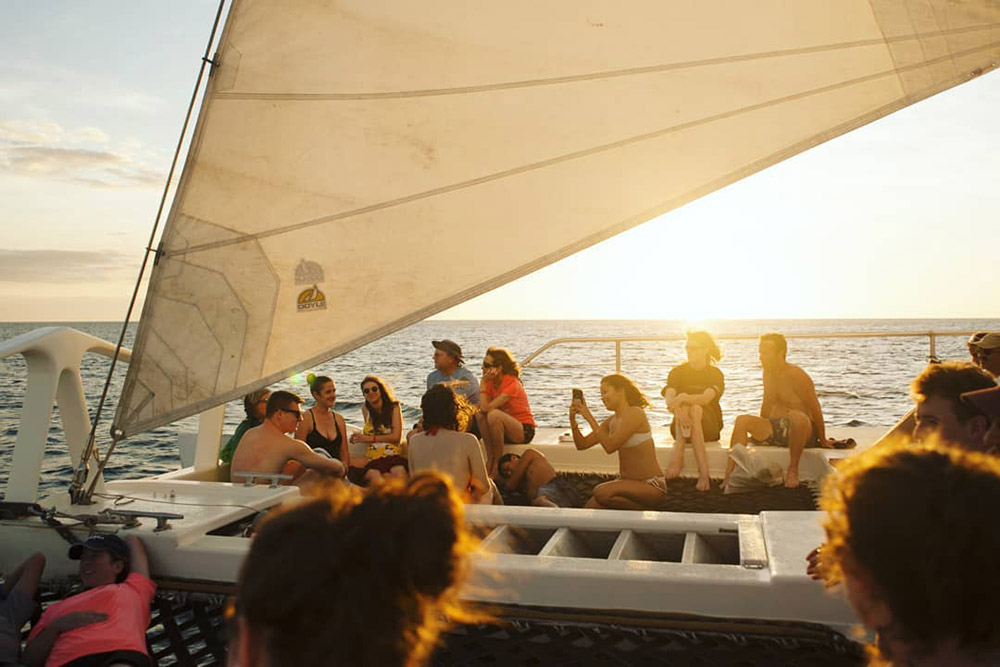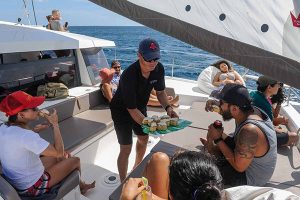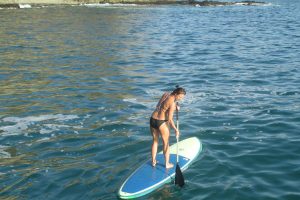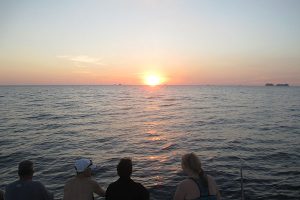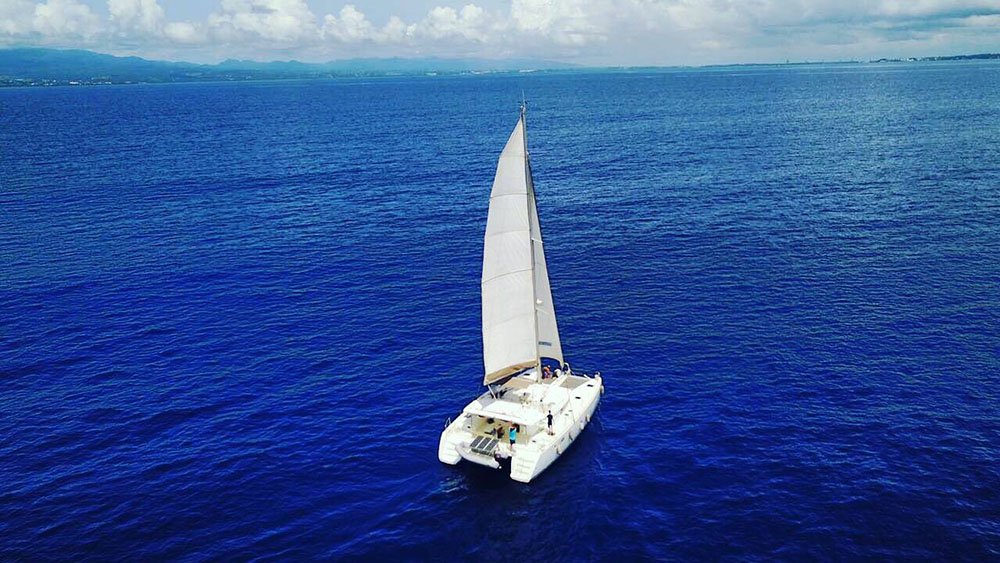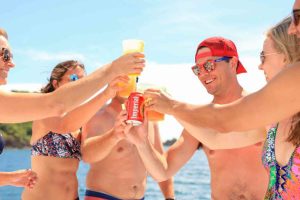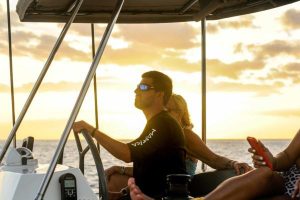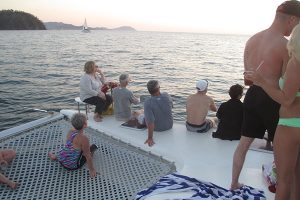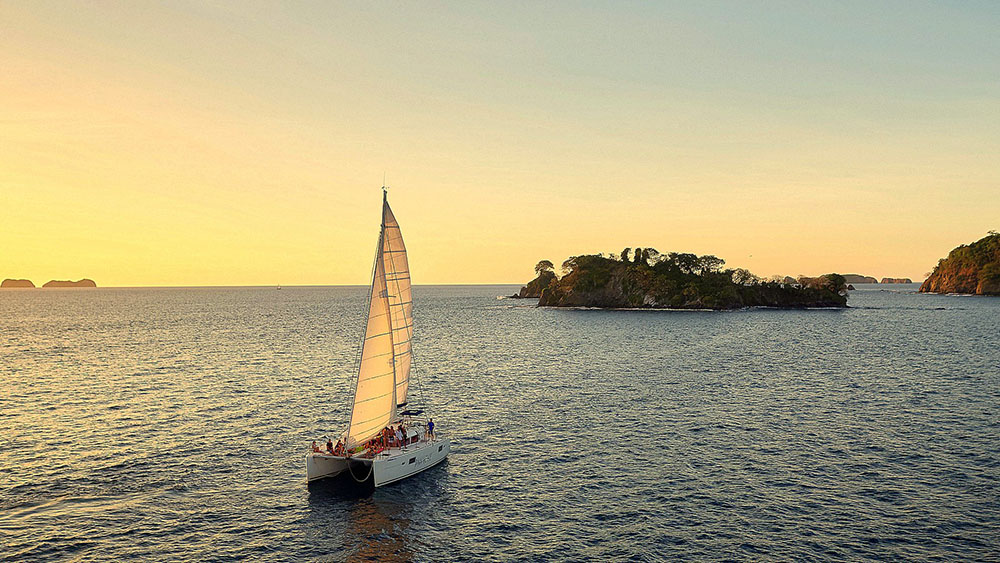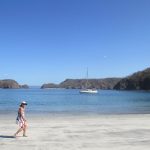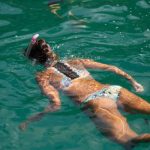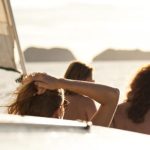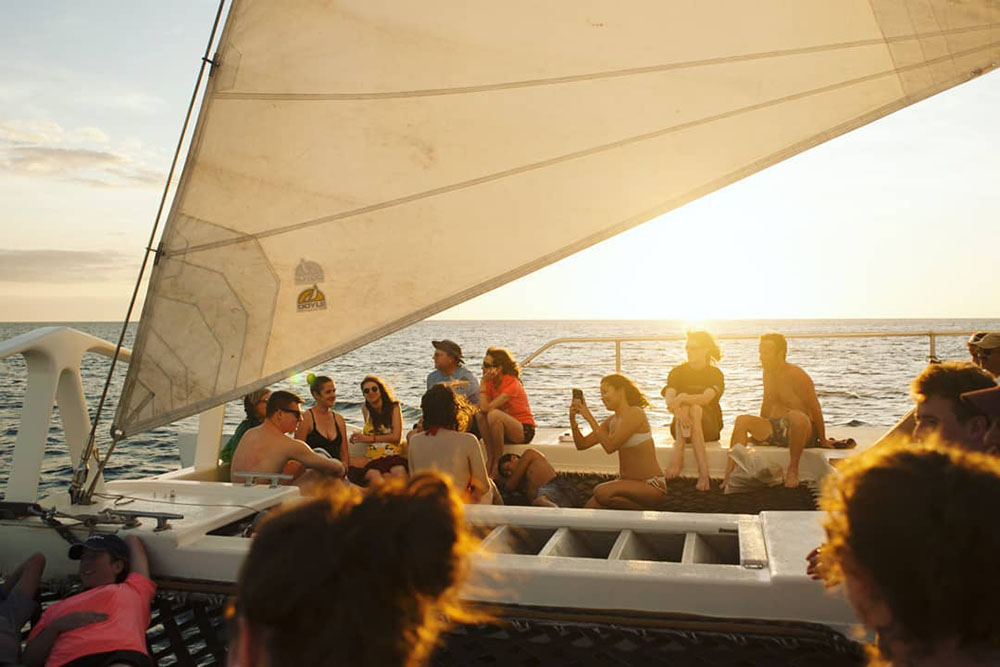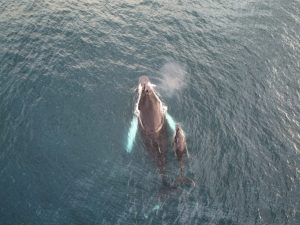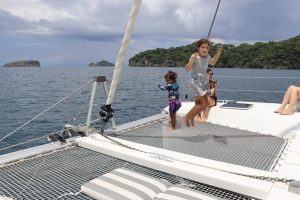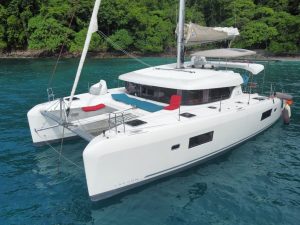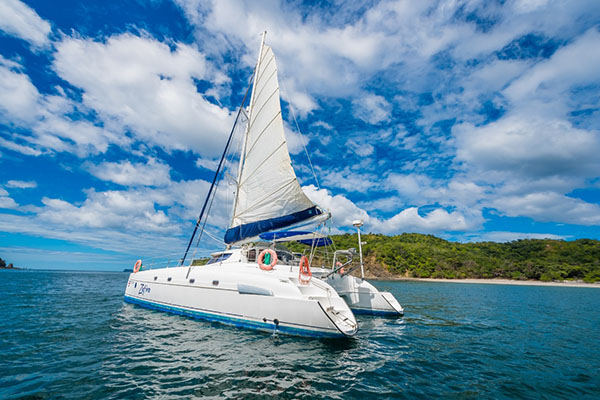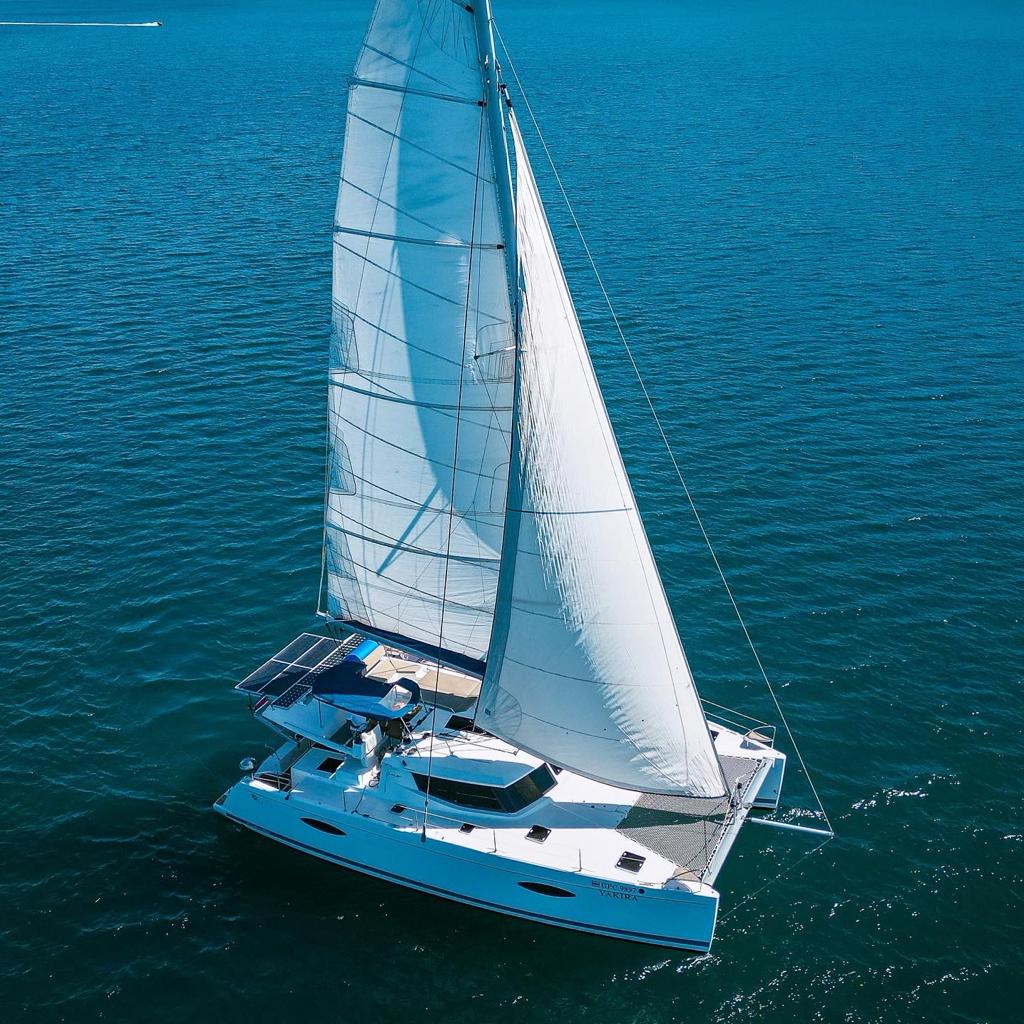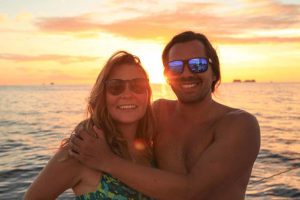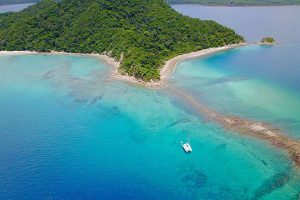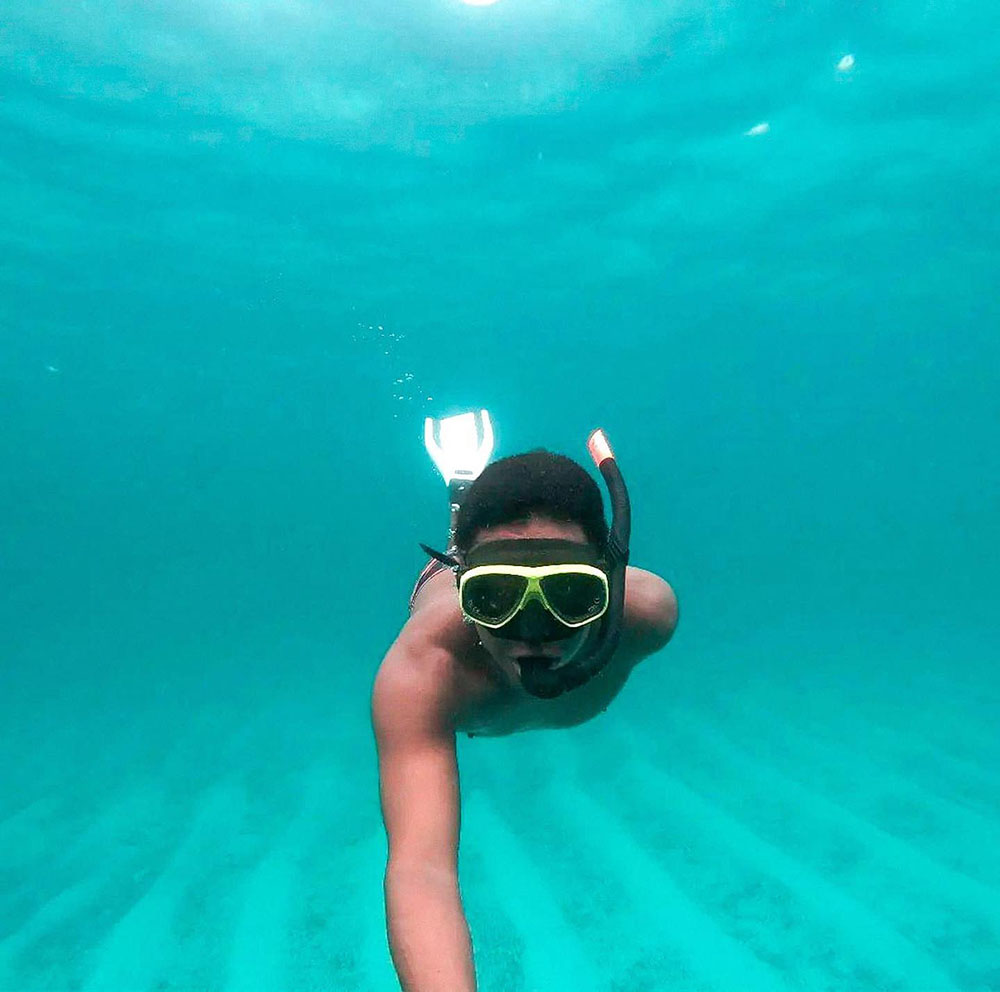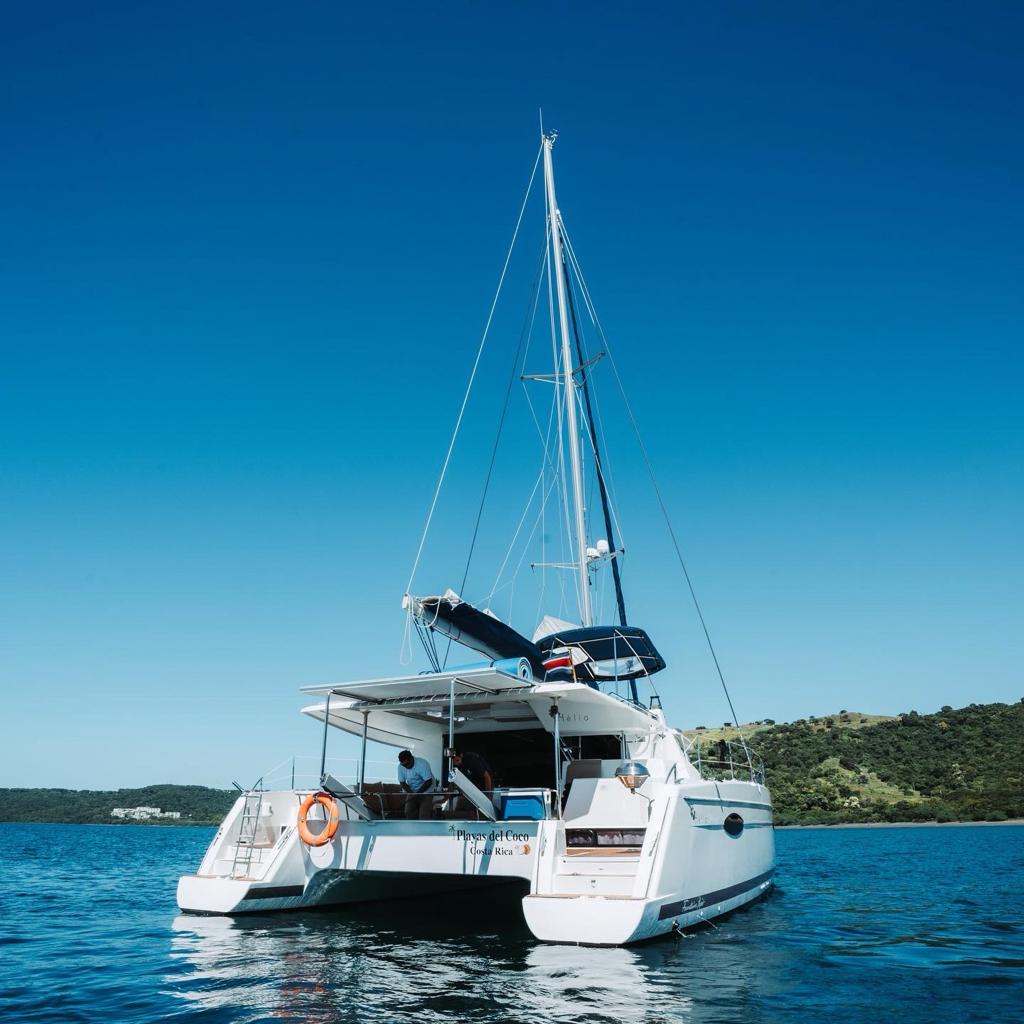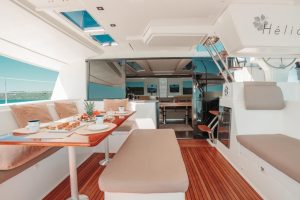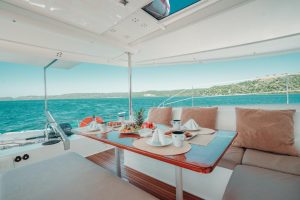JW Marriott Sunset Catamaran – Guanacaste Sailing Charters
JW Marriott Guanacaste Sunset Sailing
The JW Marriott Guanacaste sunset catamaran tour can be booked every day of the year, as long as it is booked at least 1 day in advance, and if the sailing catamaran is available.
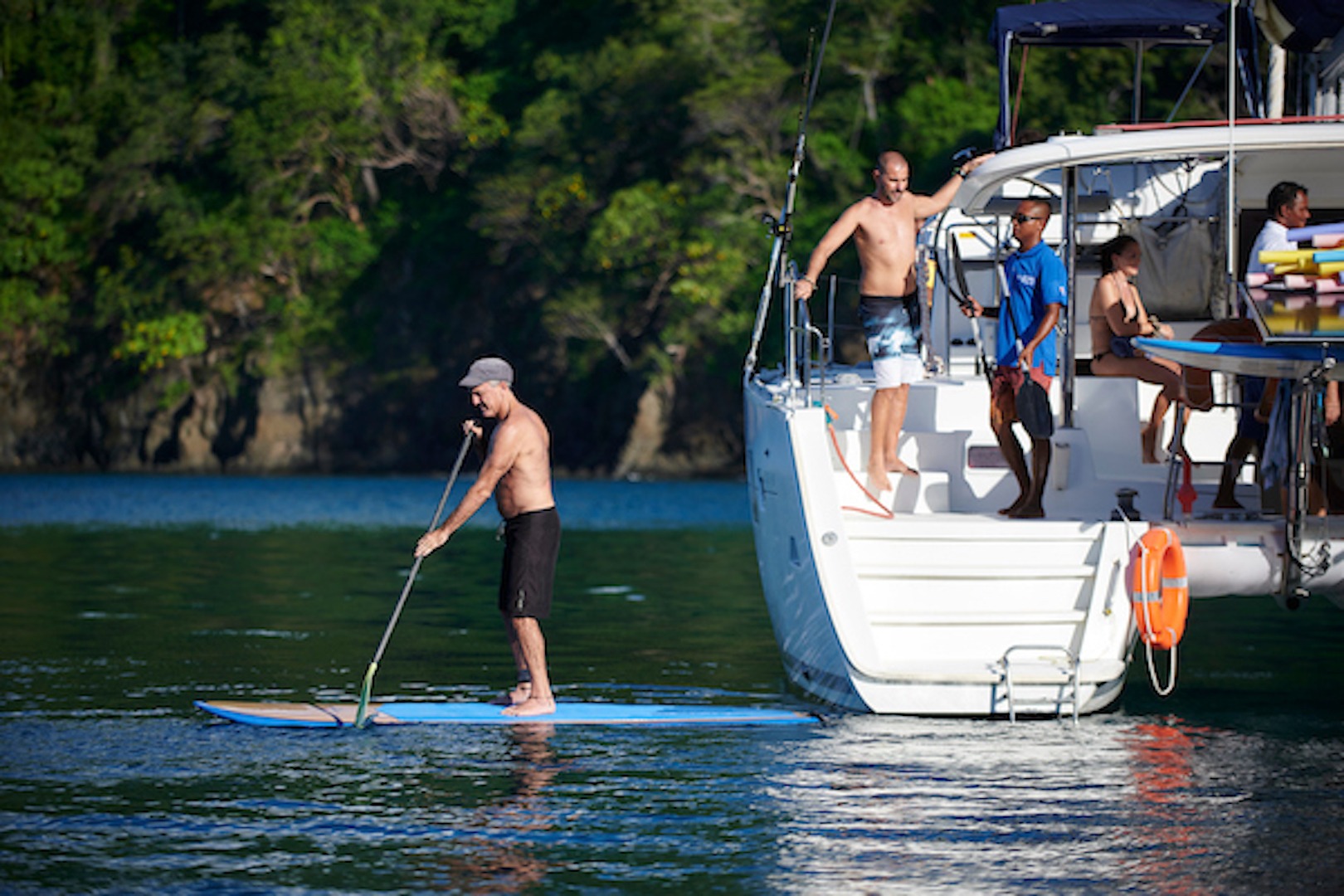
The sunset tour departs at 2:00 pm and returns normally at 6:00 pm, so guests can watch the sunset from the boat.
The best starting points are Flamingo and Conchal, since they offer better boarding sites.
The tour includes:
– Snorkeling
– Paddle boards
– Fishing rods
– Unlimited drinks
– Meals served on board by the crew
During the trip, some more natural and pristine areas will be visited, so that the clients on board can appreciate the natural part of Guanacaste, and enjoy the tranquility away from the hustle and bustle of the hotels.
On these beaches, you can swim, sunbathe, snorkel, paddle board or even fish.
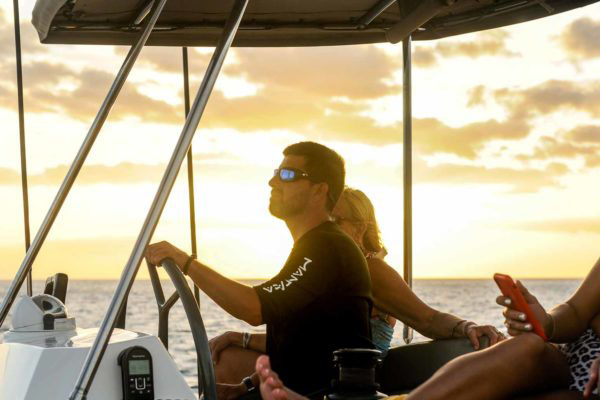
El Mangroove Papagayo Sunset Catamaran – Guanacaste Sailing Charters
El Mangroove Sunset Sailing
Private catamaran cruise
Book your private catamaran for a sunset trip departing directly from El Mangroove Papagayo, by Marriot.
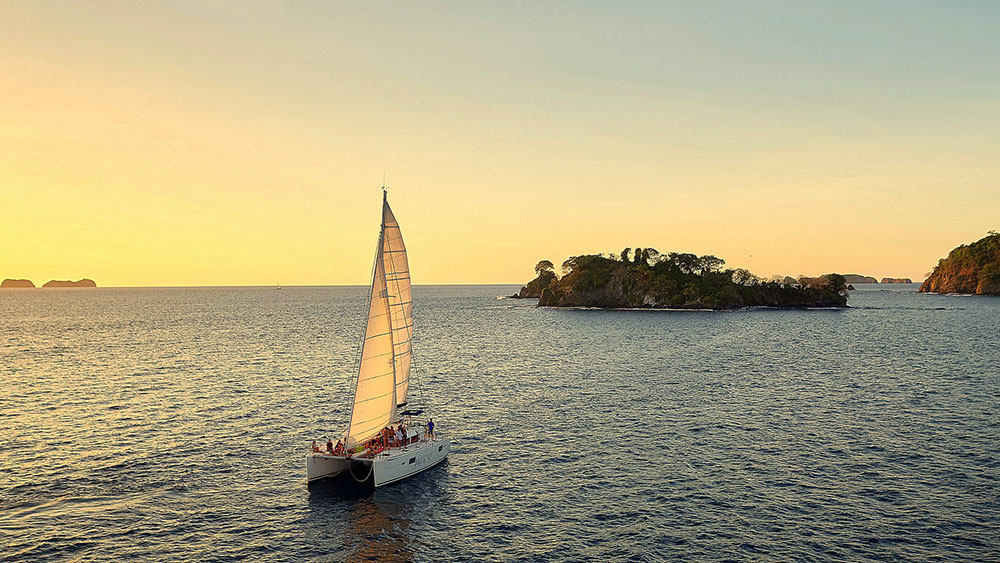
The beautiful Culebra Bay and Papagayo Peninsula create the perfect setting for a private charter tour of 4 or more hours, discovering the most remote, natural and pristine areas of this blessed coastal area of Guanacaste.
El Mangroove Papagayo Sunset Sailing
Our catamaran sailing trips allow you to get away from the hotel environment for a few hours, so you can see the quieter areas as well as the beautiful nature of the Guanacaste coastline, possibly seeing dolphins, sea turtles, coral reef fish and even whales (seasonal).
Sunset Tour
Our sunset tour departs at 2pm and returns after sunset, thus being able to see the beautiful colors of the sunset from the catamaran.
What is included:
-Drinks
-Lunch
-Snorkeling
-Paddle board
-Fishing rods
-Kayak
-Music system
-Excellent crew on board
Duration:
-4 hours
Discovering Paradise: The Enchanting El Mangroove Papagayo Resort and Hotel in Costa Rica’s Guanacaste Province
Nestled along the pristine coastline of Costa Rica’s Guanacaste Province lies a true gem of luxury and natural splendor: the breathtaking El Mangroove Papagayo Resort and Hotel. Surrounded by lush mangroves and overlooking the tranquil waters of the Gulf of Papagayo, this exquisite resort offers an unparalleled retreat for travelers seeking an unforgettable escape.
A Sanctuary of Serenity
From the moment you arrive at the resort, you are enveloped in a sense of tranquility and serenity. The resort’s contemporary design seamlessly blends with the surrounding natural environment, creating an atmosphere of understated elegance and relaxation. Every detail, from the stylish furnishings to the soothing color palette, has been carefully curated to evoke a feeling of calm and comfort.
Luxurious Accommodations
The hotel offers a variety of luxurious accommodations to suit every traveler’s needs. Whether you’re seeking a romantic getaway for two or a family vacation, you’ll find the perfect retreat among the resort’s spacious rooms, suites, and villas. Each accommodation boasts modern amenities, private terraces or balconies, and breathtaking views of either the mangrove forests or the sparkling ocean.
Indulge in Exquisite Dining
At this beautiful resort, dining is not just a culinary experience but a journey of the senses. The resort’s acclaimed restaurants offer a diverse array of flavors, from fresh seafood delicacies to authentic Costa Rican cuisine infused with international influences. Whether you’re savoring a gourmet meal at Makoko or enjoying tapas and cocktails at Matiss, every dining experience is sure to tantalize your taste buds and leave you craving more.
Unforgettable Experiences
While relaxation is paramount at the hotel and resort, it also offers a wealth of exciting activities and experiences for guests to enjoy. Explore the natural wonders of the surrounding area with guided tours of nearby national parks, embark on a thrilling adventure with snorkeling or kayaking excursions, or simply unwind by the infinity pool with a refreshing drink in hand. Whatever your preference, the resort’s dedicated staff is on hand to ensure that your stay is nothing short of extraordinary.
Environmental Stewardship
El Mangroove is not only a luxurious retreat but also a responsible steward of the environment. The resort is committed to sustainable practices, including water and energy conservation, waste reduction, and the protection of local wildlife and ecosystems. From eco-friendly amenities to community engagement initiatives, El Mangroove strives to minimize its environmental footprint while maximizing the beauty and vitality of its surroundings.
A Gateway to Paradise
For those seeking the ultimate tropical getaway, the Resort and Hotel offers an unparalleled escape to paradise. Whether you’re seeking relaxation, adventure, or simply a chance to reconnect with nature, this exquisite resort promises an experience that will linger in your memories long after you’ve returned home. Come discover the beauty of Costa Rica’s Guanacaste Province and let it whisk you away to a world of luxury, tranquility, and natural splendor.
Tamarindo Sunset Catamaran – Guanacaste Sailing Charters
Tamarindo Sunset Sailing
Private catamaran cruise
Come sail with us from Playa Tamarindo and explore remote and uninhabited beaches, far away from the hotel zones.
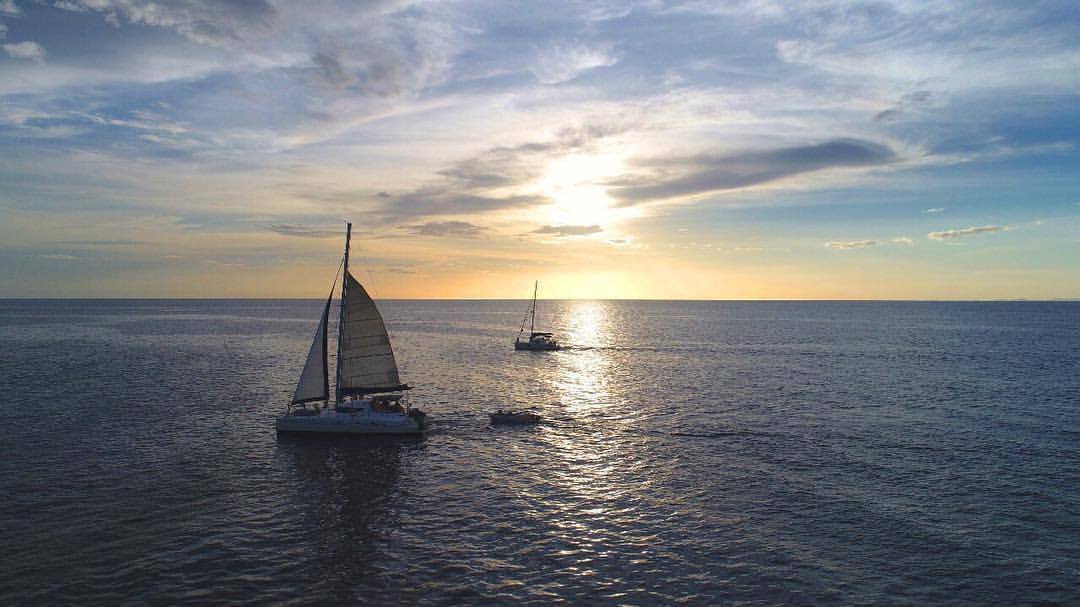
Our private charter tours take place on beautiful catamarans, yachts or sailboats of your choice, and are 100% private, with captain and crew only for the clients on board.
In addition to including drinks, delicious meals as well as a music system, we offer charters in which we actually sail and make the sails.
In addition, although we include services on board, it is a real expedition for the clients to see pristine and remote natural places, where they can enjoy snorkeling, paddle boarding, fishing and even kayaking, as well as swimming on beautiful beaches or in the sea.
Hopefully, we will be able to see dolphins and whales during the tour.
Tamarindo sunset catamaran sailing
Tour departure: 2 PM
Return from tour: 6 PM
Includes:
Drinks
Lunch
Snorkeling
Paddle boarding
Fishing rods
Kayaking
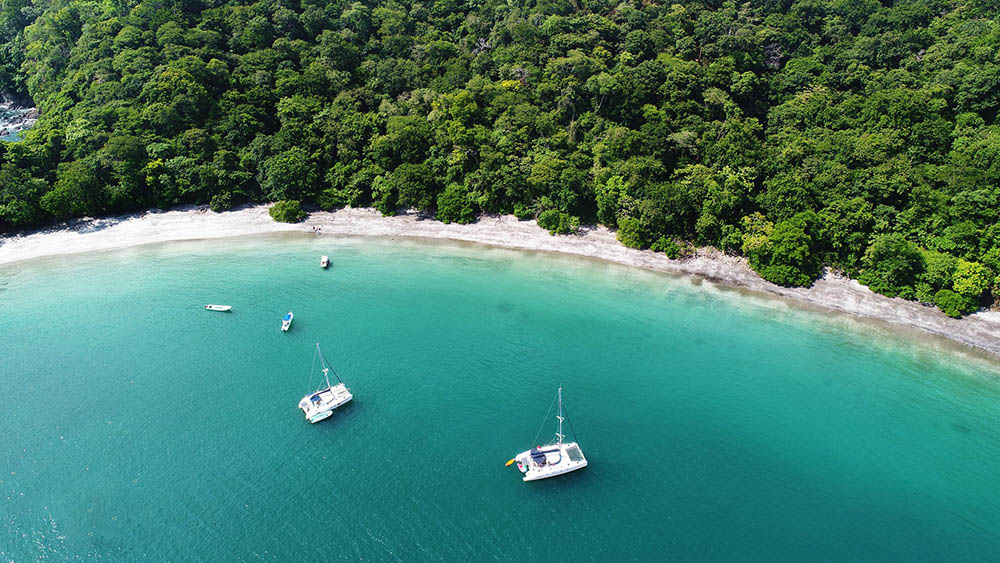
More information about Tamarindo and nearby highlights
Exploring the secluded beaches and remote natural coastline near Tamarindo Beach in Guanacaste is like stepping into a pristine paradise untouched by the rush of modern life. As you venture away from the bustling tourist hub of Tamarindo, you’ll find yourself immersed in a world of rugged beauty and tranquil serenity.
One of the hidden gems awaiting discovery is Playa Grande, a stunning stretch of coastline just a short boat ride or drive from Tamarindo. Accessible only by foot or water, Playa Grande offers a sense of seclusion that’s hard to find elsewhere. As you make your way along the sandy shores, you’ll be greeted by the rhythmic sound of crashing waves and the call of seabirds soaring overhead.
Further along the coast, you’ll encounter Playa Conchal, known for its unique shoreline composed of millions of crushed shells. This natural wonder creates a mosaic of colors, ranging from ivory white to shades of pink and beige, shimmering in the sunlight. The crystal-clear waters beckon you to dive in and explore the vibrant marine life thriving beneath the surface.
For the adventurous spirit, a hike to Playa Minas reveals a rugged coastline dotted with hidden coves and tidal pools teeming with marine treasures. As you traverse the rocky terrain, keep an eye out for native wildlife such as howler monkeys swinging through the treetops and iguanas basking in the sun.
As the day draws to a close, there’s no better way to unwind than with a sunset stroll along Playa Langosta. Here, the golden hour casts a warm glow over the horizon, painting the sky in hues of orange and pink as the sun dips below the sea. It’s a moment of pure tranquility, where time seems to stand still and the beauty of nature takes center stage.
Exploring the secluded beaches and remote coastline near Tamarindo Beach offers a glimpse into the untamed beauty of Costa Rica’s Guanacaste region. Whether you’re seeking adventure or simply craving a moment of peaceful solitude, this coastal paradise has something to offer every traveler willing to venture off the beaten path.
Secrets Papagayo Sunset Catamaran – Guanacaste Sailing Charters
Secrets Papagayo Sunset Sailing
Private catamaran cruise
Watch the sunset from our sailing catamaran as it sails back to shore, a unique and memorable experience.
The sunset tour is one of the most popular tours we offer from Secrets Papagayo, perhaps because besides including an ocean eco adventure (snorkeling, paddle boards, kayaking and kayaking included) it offers of course the chance to admire the unique and fantastic sunsets of the Papagayo Peninsula in Guanacaste.
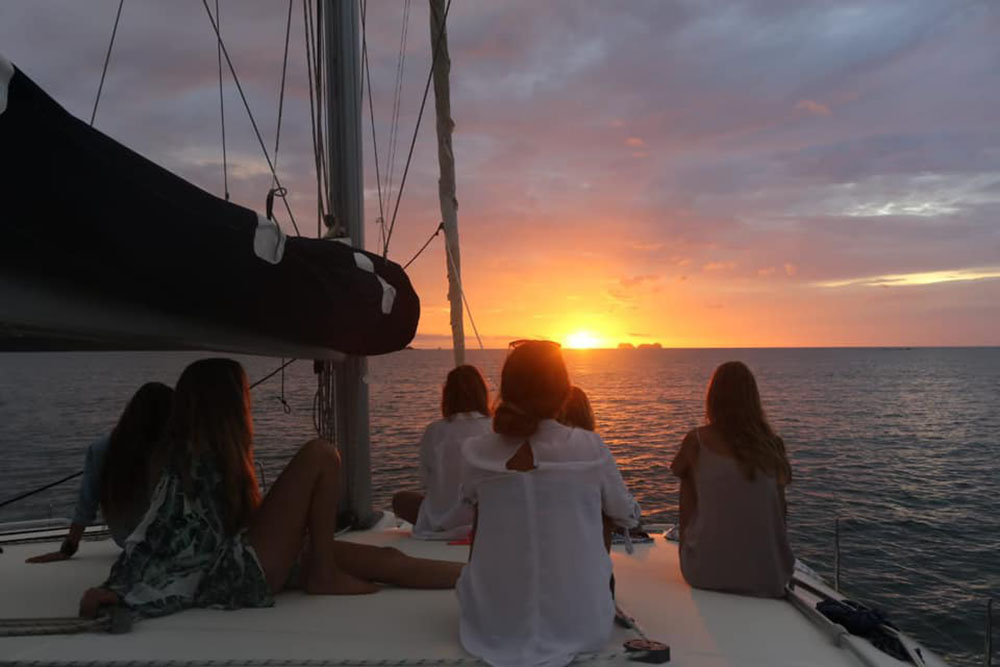
The tour departs at 2 pm and returns after sunset, around 6 pm. During the tour we will sail along the most pristine and natural coast of the Peninsula, visiting a beautiful natural beach, and enjoying activities such as snorkeling, paddle boarding, fishing (if you catch something our crew will prepare it in Sashimi). Other services you can enjoy are open bar, delicious meals, sound system to listen to your own music and attention from our crew.
More than a party tour, an ocean expedition.
During some months of the year, it is even possible to see whales (July to October and January and February), while sea turtles as well as dolphins and sometimes even monkeys are resident species that are quite abundant.
Secrets Papagayo Resort
Discovering Paradise: Secrets Papagayo Resort in Guanacaste, Costa Rica
Nestled along the pristine shores of the Pacific Ocean in the lush province of Guanacaste, Costa Rica, lies the epitome of luxury and tranquility: Secrets Papagayo Resort. Tucked away in a secluded bay surrounded by tropical forests, this all-inclusive, adults-only haven offers a haven for relaxation and adventure alike.
A Sanctuary of Serenity
As you step foot into the hotel, you are immediately greeted by the warm Costa Rican hospitality and a sense of calm that permeates the air. The resort’s architecture seamlessly blends with its natural surroundings, creating a harmonious ambiance that invites guests to unwind and rejuvenate.
Luxurious Accommodations
The resort boasts a range of luxurious accommodations, including spacious suites and villas, each offering breathtaking views of the Pacific Ocean or the lush tropical gardens. Whether you choose a swim-out suite for direct access to a private pool or an oceanfront villa for panoramic vistas, every detail has been meticulously designed to ensure your comfort and satisfaction.
Culinary Delights
At Secrets , dining is an experience to savor. With a diverse array of gourmet restaurants offering everything from traditional Costa Rican cuisine to international delicacies, guests can indulge their palates in a culinary journey unlike any other. Whether you’re enjoying fresh seafood by the beach or savoring fine dining under the stars, each meal is a celebration of flavor and innovation.
Endless Activities
For those seeking adventure, the hotel offers a myriad of activities to suit every interest. From snorkeling and paddleboarding in the crystal-clear waters to hiking through the lush rainforest or embarking on a thrilling zip-lining excursion, there is no shortage of opportunities to explore the natural beauty of Guanacaste.
Relaxation and Wellness
For those in need of relaxation, the resort’s world-class spa provides a sanctuary for rejuvenation and renewal. Offering an extensive menu of holistic treatments inspired by indigenous rituals, guests can indulge in massages, facials, and body scrubs designed to nourish the mind, body, and soul.
Sustainable Luxury
As a responsible steward of the environment, the resort is committed to sustainability and eco-conscious practices. From implementing energy-efficient technologies to supporting local conservation efforts, the resort strives to minimize its ecological footprint while preserving the natural beauty of Guanacaste for future generations to enjoy.
The Secrets Experience
What sets Secrets Papagayo apart is its unwavering commitment to providing an unparalleled guest experience. From the moment you arrive until the moment you depart, the dedicated staff go above and beyond to ensure your every need is met with genuine care and attention to detail. Whether it’s arranging a romantic dinner on the beach or organizing an exhilarating excursion, no request is too big or too small.
Andaz Papagayo Sunset Catamaran – Guanacaste Sailing Charters
Andaz Papagayo Sunset Sailing
Private catamaran cruise
Venture with us and sail in our private charter at sunset to discover the most natural and beautiful regions near Andaz Papagayo.
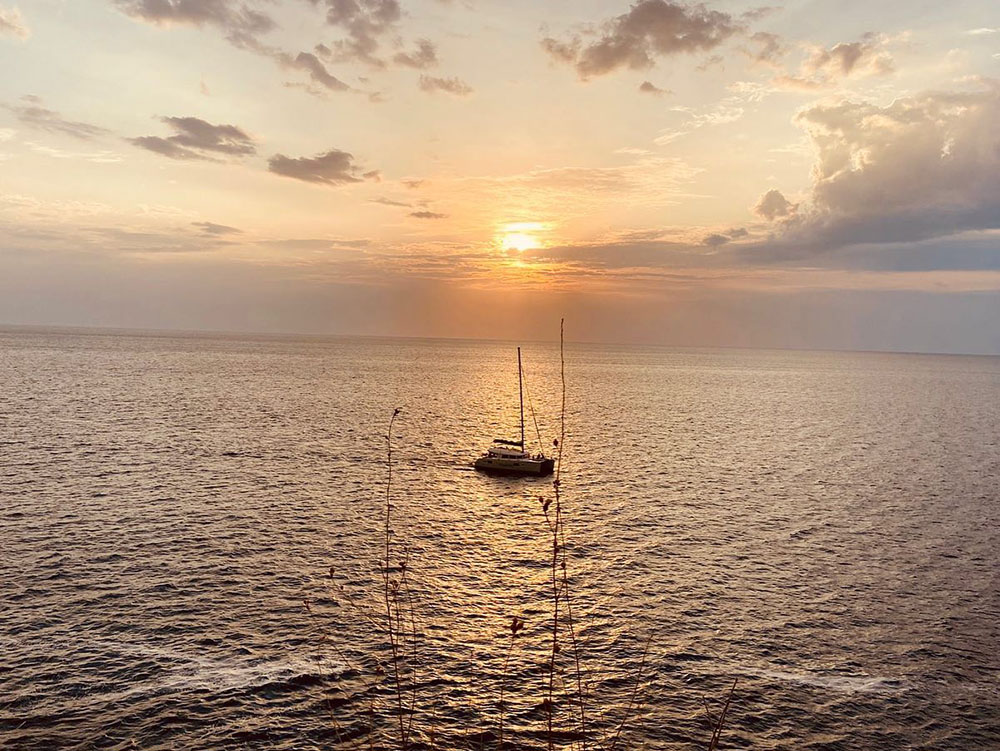
As if that were not enough, you will be able to watch the fantastic sunset from aboard the sailing catamaran, an unmissable spectacle and one of the iconic attractions of your vacation in Guanacaste.
What is the tour about ?
We pick up our clients directly on the beach in front of the hotel, something that enhances the experience even more, because there is no need to mobilize to a nearby port. a true private experience, a 4 hour expedition.
The tour starts at 2 pm and ends at 6 pm, and during these four hours, you will be able to admire and enjoy a pristine beach, the sea, or practice some of the included activities, such as snorkeling, paddle boarding or fishing. Additionally, the tour includes drinks and meals, prepared by the catamaran crew.
What is included:
– Snorkeling
– Paddle boars
– Kayaks ( ask )
– Fishing rods
– Open bar
– Meals
– Sound system
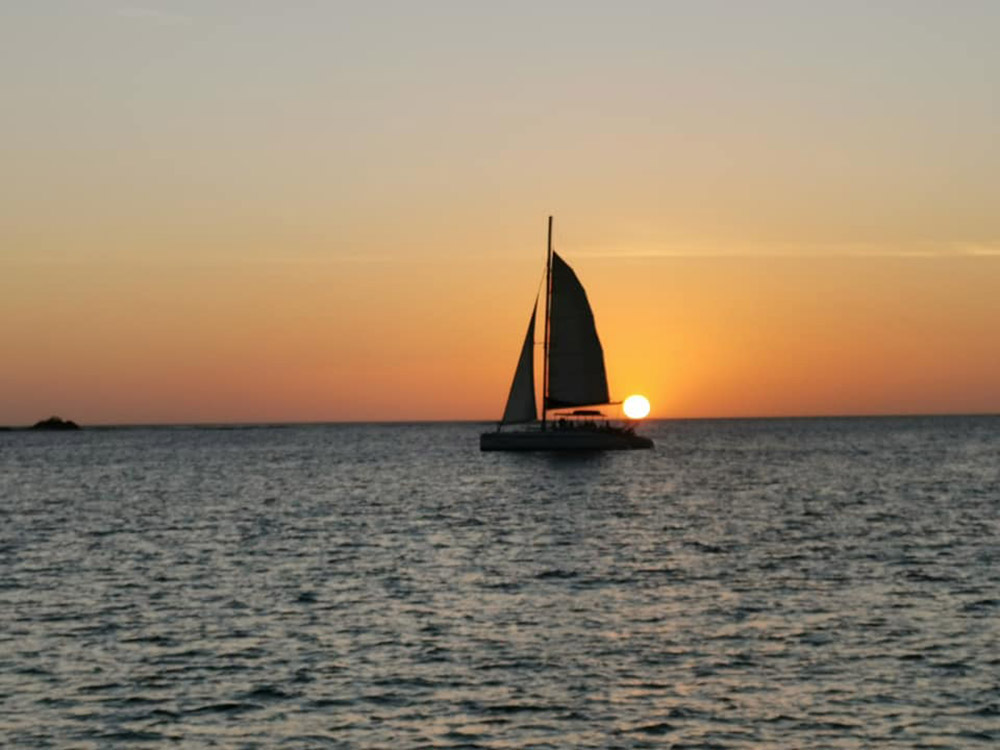
Discovering Tranquility and Luxury at Andaz Papagayo Resort in Guanacaste, Costa Rica
Tucked away on the pristine shores of the Papagayo Peninsula in Guanacaste, Costa Rica, lies a sanctuary of modern elegance and natural beauty: Andaz Papagayo Resort. With its striking architecture, immersive experiences, and commitment to sustainability, Andaz Papagayo offers guests an unforgettable escape in one of the most breathtaking destinations in Central America.
A Design Oasis in Harmony with Nature
It stands as a testament to contemporary design seamlessly integrated into its lush surroundings. The resort’s architecture draws inspiration from the vibrant colors and textures of Costa Rica’s natural landscape, with open-air spaces, locally sourced materials, and panoramic views of the Pacific Ocean and surrounding rainforest at every turn. Designed to foster a sense of connection with nature, it offers guests an immersive experience that celebrates the beauty of Guanacaste.
Luxurious Accommodations
From stylish guest rooms to lavish suites and private villas, it offers a range of accommodations designed to cater to every traveler’s needs. Each room features modern amenities, elegant furnishings, and thoughtful touches inspired by Costa Rican culture. Whether you’re seeking a romantic retreat for two or a family-friendly getaway, the resort provides a serene and comfortable haven to call home during your stay.
Culinary Delights
At the resort, dining is a culinary journey that celebrates the flavors of Costa Rica and beyond. The resort’s restaurants offer an array of culinary experiences, from farm-to-table cuisine made with locally sourced ingredients to innovative dishes inspired by international flavors. Guests can savor delicious meals while soaking in panoramic views of the ocean or enjoying the vibrant ambiance of the resort’s dining venues.
Immersive Experiences
Andaz Papagayo goes beyond traditional hospitality to offer guests immersive experiences that showcase the beauty and culture of Guanacaste. Whether it’s embarking on a guided nature hike through the rainforest, kayaking along the pristine coastline, or learning about local art and traditions through interactive workshops, there’s always something new to discover at the resort. Guests can also unwind and rejuvenate at the tranquil Onda Spa, where a range of holistic treatments and wellness activities await.
Commitment to Sustainability
As a responsible steward of the environment, the resort is committed to sustainable practices that minimize its impact on the surrounding ecosystem. From implementing energy-efficient technologies to supporting local conservation initiatives, the resort strives to preserve the natural beauty of Guanacaste for future generations to enjoy. Guests can feel good knowing that their stay at Andaz Papagayo supports environmentally conscious hospitality.
Planet Hollywood Papagayo Sunset Catamaran – Guanacaste Sailing Charters
Planey Hollywood Papagayo Sunset Sailing
Private catamaran cruise
Our private sunset tour from Planet Hollywood Papagayo is one of the most requested, as our clients like to be able to watch the sunset from aboard the catamaran, as they slowly make their way back to shore.
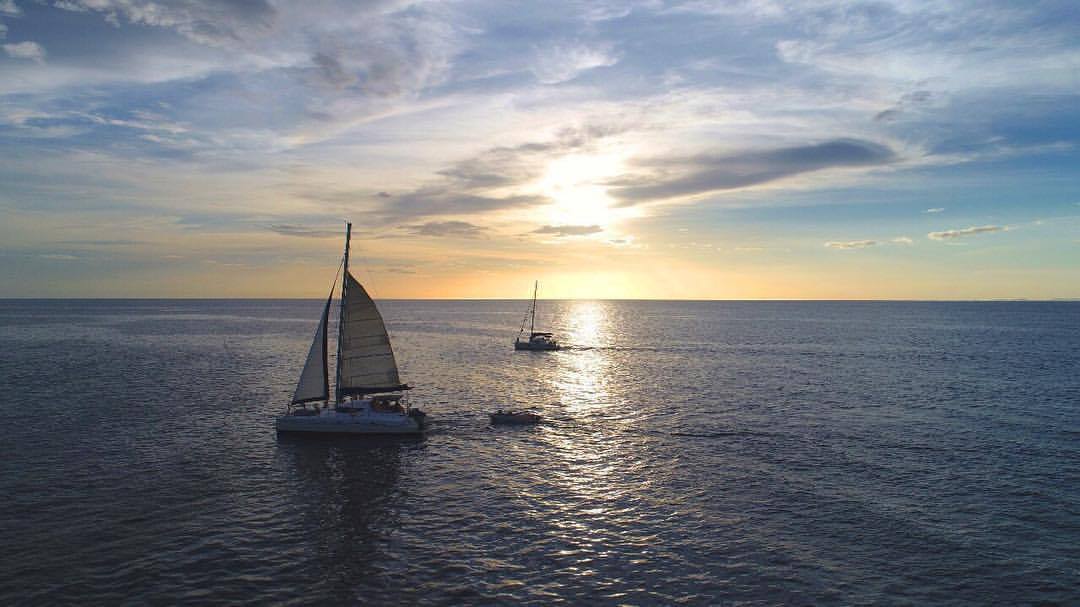
Another advantage in the case of Planet Hollywood Papagayo is that the hotel has a beach in front, which enables us to pick up our clients directly from the beach, without the need to go to a nearby port or dock.
Description:
The private sunset catamaran departs at 2 pm and returns after sunset, around 6 pm.
Like all our other private tours, we include unlimited drinks with a good variety of beverages, as well as delicious food served on board by the crew.
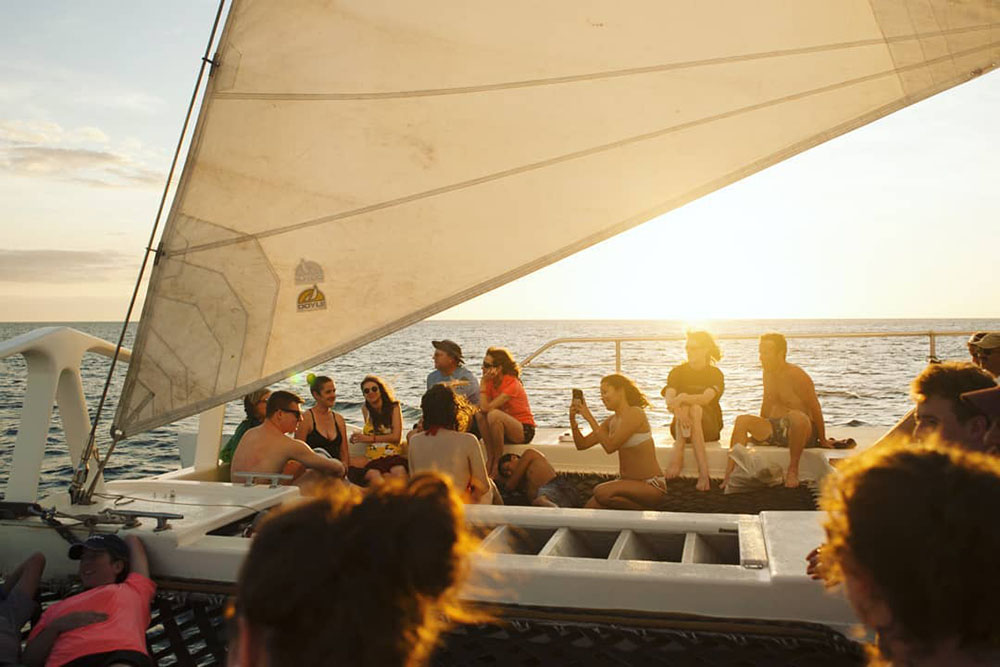
Additionally, the trip includes snorkeling equipment, paddle boards, trolling poles and other toys.
The emphasis of the tour, as with all of our tours, is nature, and being able to sail, really set sail, to pristine and remote sites, usually along the Papagayo Peninsula.
The westernmost part of the Peninsula has beautiful undeveloped beaches, where again, our clients can enjoy nature. Hopefully on the way we can see sea turtles, dolphins and with some luck, even monkeys that inhabit the dry forests of the peninsula.
Snorkeling and other activities
Snorkeling is also an essential activity of the tour, and depending on visibility, many coral reef fish can be seen at one of the many points we sail to.
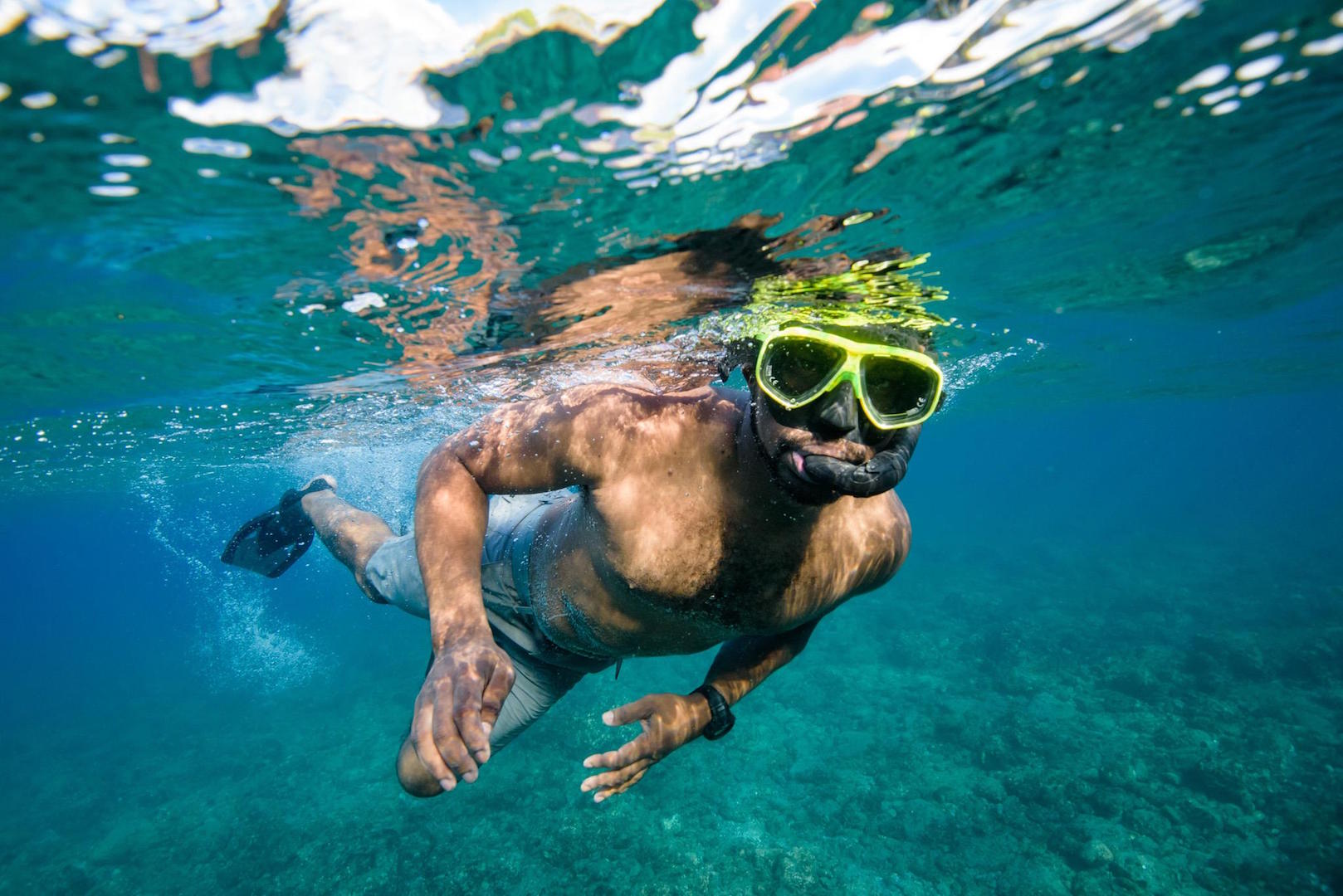
Planet Hollywood Papagayo
Exploring the Exotic Charm of Planet Hollywood Papagayo in Guanacaste, Costa Rica
Nestled along the stunning shores of the Pacific Ocean in the captivating region of Guanacaste, Costa Rica, lies a haven where luxury, entertainment, and natural beauty converge seamlessly. Welcome to Planet Hollywood Papagayo, a lavish resort that epitomizes the essence of Hollywood glamour amidst the lush landscapes of Central America.
A Hollywood Oasis in the Heart of Guanacaste
This is not just a resort; it’s an experience crafted to enchant and indulge guests in the magic of Hollywood while immersing them in the tropical splendor of Costa Rica. As part of the renowned Planet Hollywood brand, the resort effortlessly blends the glitz and glamour of Hollywood with the laid-back charm of Guanacaste, creating a unique and unforgettable vacation destination.
Luxurious Accommodations
Upon arriving, guests are welcomed into a world of luxury and comfort. The resort boasts a range of exquisite accommodations, including stylish suites and opulent villas, each meticulously designed to provide the utmost in comfort and relaxation. Whether you’re seeking a romantic getaway for two or a family-friendly retreat, there’s a perfect lodging option to suit every taste and preference.
A Culinary Journey
One of the highlights of any stay at the resort is the exceptional dining experience. From gourmet cuisine inspired by global flavors to classic comfort foods with a Hollywood twist, the resort’s restaurants offer a culinary journey like no other. Indulge in mouthwatering dishes crafted by talented chefs, and savor every bite against the backdrop of breathtaking ocean views.
Entertainment Extravaganza
At Planet Hollywood Papagayo, entertainment knows no bounds. From live performances and musical acts to themed parties and immersive experiences, there’s never a dull moment at this vibrant resort. Guests can dance the night away at the resort’s lively nightclubs, catch a blockbuster movie under the stars, or test their luck at the glamorous on-site casino.
Adventure Awaits
While relaxation is certainly on the agenda at this all inclusive resort, so too is adventure. The resort offers a plethora of exciting outdoor activities and water sports, allowing guests to explore the natural wonders of Guanacaste. From snorkeling and diving in crystal-clear waters to zip-lining through the jungle canopy, there’s no shortage of adrenaline-pumping adventures to be had.
Unparalleled Wellness
For those seeking rejuvenation and relaxation, Planet Hollywood Papagayo’s wellness facilities are second to none. Pamper yourself with a rejuvenating spa treatment, unwind with a yoga session overlooking the ocean, or simply soak up the sun by the resort’s sparkling pools. Whatever your idea of relaxation may be, you’ll find it here in abundance.
Sustainable Luxury
As a responsible steward of the environment, the resort is committed to sustainability and eco-conscious practices. From implementing energy-efficient technologies to supporting local conservation efforts, the resort strives to minimize its environmental footprint while maximizing the guest experience. By choosing to stay at this well located beach hotel, guests can rest assured that they’re contributing to the preservation of Costa Rica’s natural beauty for generations to come.
Explorer Catamaran – Guanacaste Sailing Charters
Explorer Catamaran
Private sailing trip from Guanacaste
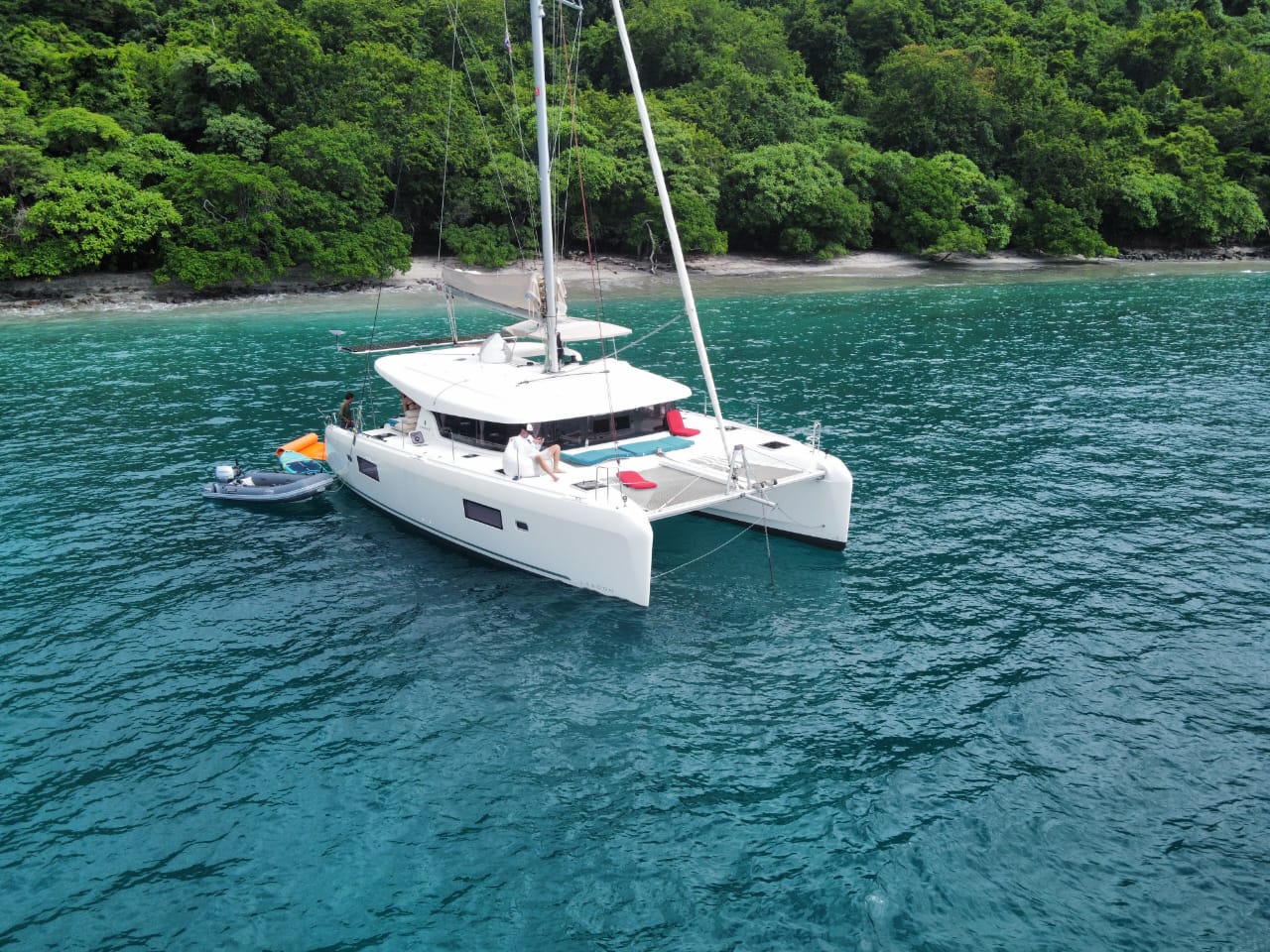
The Explorer is a beautiful Laguna Catamaran serving our clients in the Papagayo area, including the Papagayo Peninsula, Playa Manama Beach, El Coco, Hermosa, Riu and all the hotels and beachside resorts in the area.
This 46 footer catamaran comes with all the necessary for a fun ocean expeditions, and at the same time, all services for a pleasant and comfortable private sailing tour.
Services include:
- Open bar
- Great food items
- Snorkeling
- Paddle board
- Fishing rods
- Bluetooth soundsystem
- Onboard service by the crew
The catamaran incldues:
- Several abthrooms
- Large interior saloon with kitchen and bar
- Trampoline and abundant seating area both indoors and outdoors
Private charters
During our sailing trips, our crew will take you to the more secluded and pristine areas in Papagayo.
The Explorer Catamaran is a remarkable vessel designed to provide an unparalleled experience for those seeking to explore the secluded and pristine areas of the Papagayo Peninsula region in Guanacaste. This catamaran is specifically tailored for adventure seekers who wish to immerse themselves in the beauty of nature while enjoying a range of water activities.
One of the standout features of the Explorer Catamaran is its versatility, offering half-day trips, full-day sailing adventures, and captivating 4-hour sunset charters. This allows visitors to customize their experience based on their preferences and time constraints, ensuring a perfect blend of relaxation and excitement.
The catamaran’s design is optimized for comfort and stability, providing a smooth and enjoyable ride as it navigates through the crystal-clear waters surrounding the Papagayo Peninsula. The spacious deck offers ample room for guests to relax and soak in the breathtaking scenery, whether it’s the lush green landscapes, vibrant coral reefs, or the azure waters stretching out as far as the eye can see.
For those who crave adventure beneath the waves, the Explorer Catamaran provides an array of water activities. Snorkeling enthusiasts can explore the vibrant marine life thriving in the hidden coves and coral formations. Paddle boarding is another popular option, allowing guests to leisurely cruise along the coastline, discovering secluded beaches accessible only by water.
One of the most enchanting aspects of the Explorer Catamaran experience is the possibility of encountering marine life during the journey. Dolphins frequently grace the waters of the Papagayo Peninsula, providing an unforgettable spectacle as they playfully swim alongside the catamaran. Lucky visitors may even witness the majestic sight of whales passing through the area, adding a touch of magic to the adventure.
The half-day trips and full-day sailing adventures ensure that guests have ample time to explore multiple locations, discovering hidden gems and secluded coves along the coastline. These excursions allow for a deeper connection with nature and create lasting memories of the Papagayo Peninsula’s untouched beauty.
As the day comes to an end, the 4-hour sunset charter offers a romantic and awe-inspiring experience. Guests can bask in the warm glow of the setting sun while sipping on refreshing beverages, creating a perfect moment to unwind and reflect on the day’s adventures.
Whether seeking thrilling water activities, serene relaxation, or the chance to witness marine wonders, the Explorer Catamaran promises an unforgettable journey through the pristine and secluded landscapes of the Papagayo Peninsula region in Guanacaste.
Playa Grande Sailing – Guanacaste Catamaran Charters
Playa Grande Beach Sunset Sailing
Guanacaste private catamaran sailing cruises
Yaqueera Catamaran – Guanacaste Sailing Charters
Yaqueera Catamaran
Private sailing trip from Guanacaste
Yaqueera is a new, large, 44 feet Fountain Pajot luxury catamaran for those interested in luxury sailing trips. The catamaran offers a lot of space, , rich furnishings, intimate and spacious bedrooms and bathrooms.
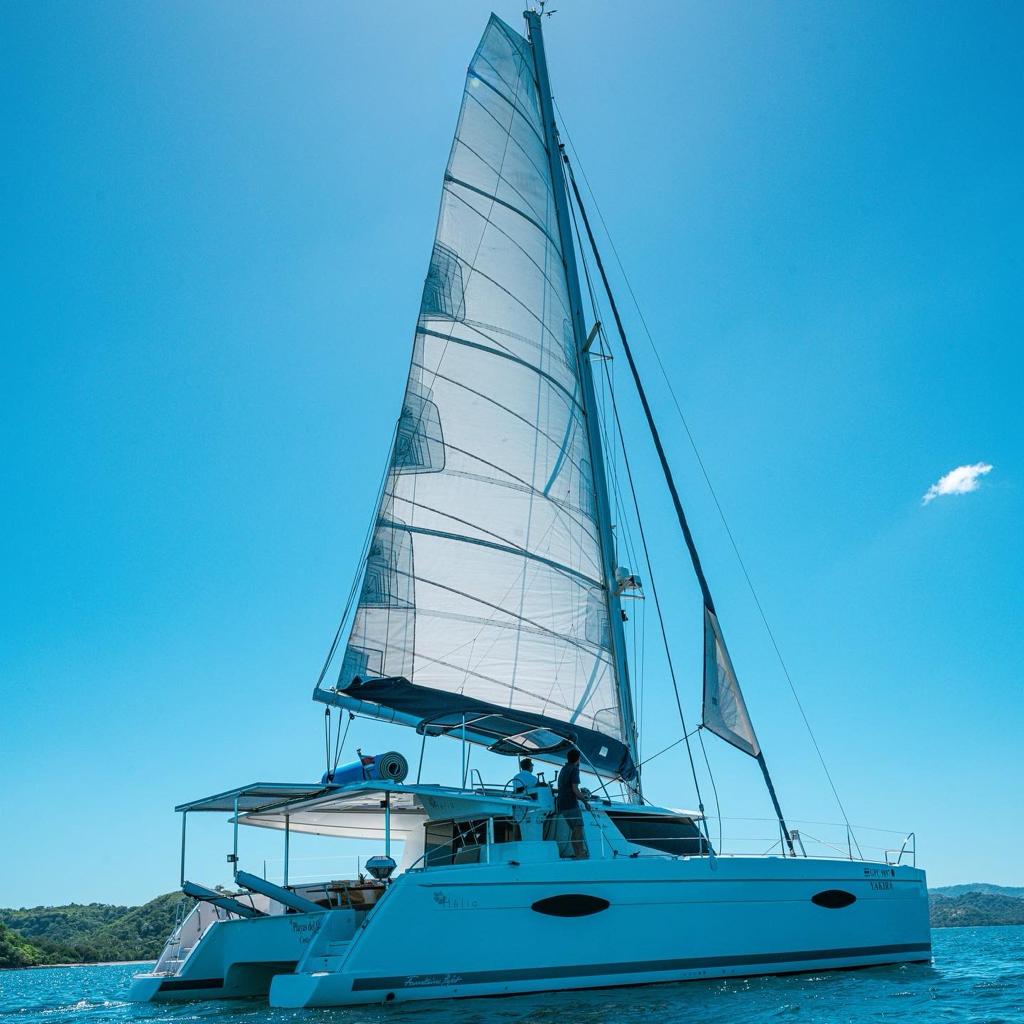
Bathrooms, beds and kitchen are new furnished from Zara hoe, and the entire interior comes with air conditioning.
There is a lot of indoor and outdoor seating area, open air and shaded. The large interior saloon comes with kitchen and bar.
Included:
Each tour includes snorkeling, fishing rods and paddle boards, as well as aa dingui in order to transport clients from the beach and to the beach, during boarding or during a trip.
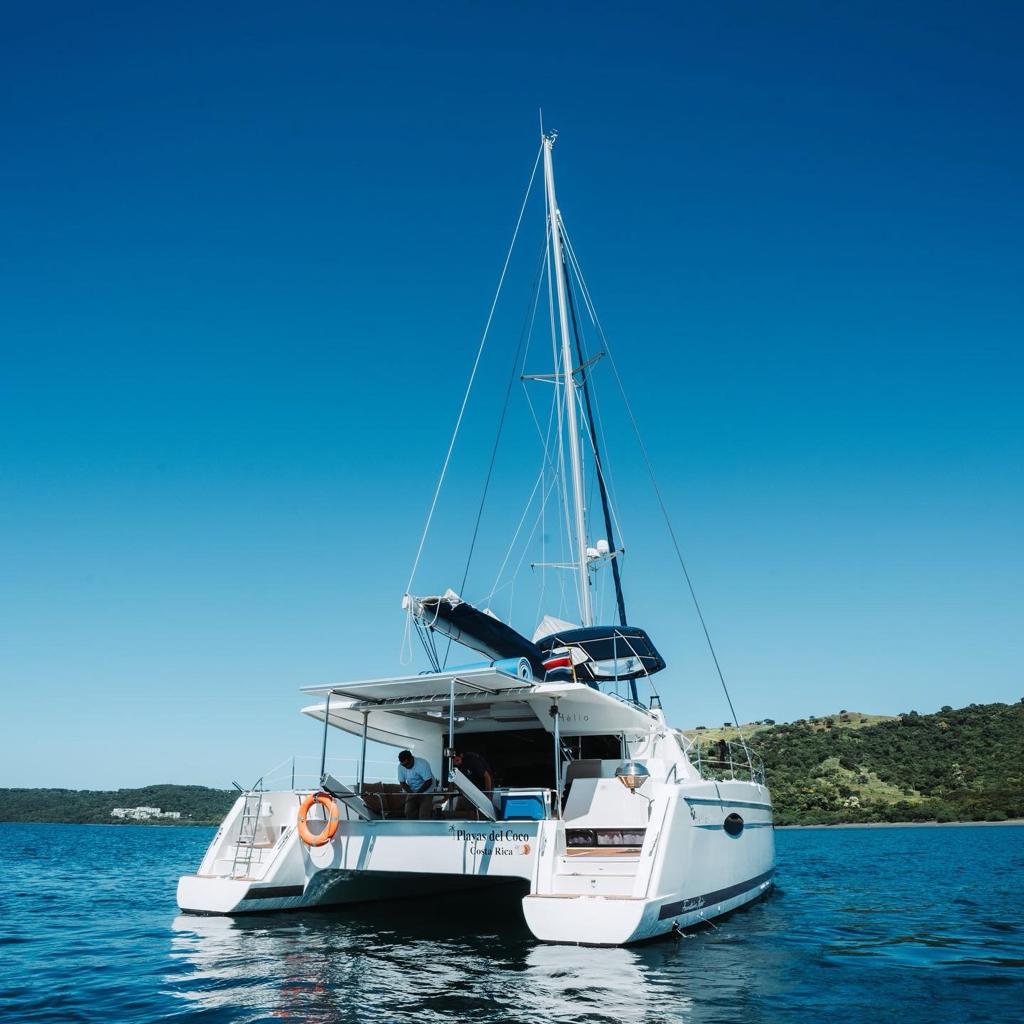
Drinks
- Open bar: National beers. Imperial light, Imperial regular and Pilsner
- Cocktails: Mojitos, Piña Coladas, Margaritas, Daikiris, Cosmopolitan, Caipirinhas.
- Spirits: Rum (dark and white), Vodka, Tequila (dark and white), Cacique, Whiskey
- Soft drinks: Orange Fanta, Sprite, Regular Coke, Zero Coke, fresh
- Wines: White wine, Red wine, Sparkling wine, Rose wine.
- Water cans
- Orange juice
- Cold tea
- Fruit juice
Food (snacks)
- Fruits: watermelon, pineapple, kiwis, green grapes, bananas, strawberries
- Snacks: cheese platter 3 types of cheese salamis, serrano ham, green olives pico de gallo, guacamole ground beans (arranged) Tuna Dip
- Cold pasta (screwfish) with tuna, peaches and green apple
- Chips: scups, corn tortillas, ripe plantains, and patacones.
- Cookies: Oreo cookies, small mouth cookies.
- Flour tortillas (gluten free)
